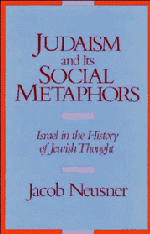Book contents
- Frontmatter
- Contents
- Preface
- List of Abbreviations
- Introduction
- 1 Imagining Society, Re-visioning “Israel”
- PART I “Israel” in the First Statement of Judaism, 70–300 C.E.
- PART II “Israel” in the Second Statement of Judaism, 300–600 C.E.
- 6 “Israel” on Its Own Terms
- 7 “Israel” as Family
- 8 “Israel” as Family and Also Singular Nation
- 9 “Israel” as Sui Generis
- 10 The Second Phase of the Judaism of the Dual Torah and Its Social Metaphors
- PART III Same Metaphors, Other Systems
- General Index
- Index to Biblical and Talmudic References
9 - “Israel” as Sui Generis
Published online by Cambridge University Press: 04 August 2010
- Frontmatter
- Contents
- Preface
- List of Abbreviations
- Introduction
- 1 Imagining Society, Re-visioning “Israel”
- PART I “Israel” in the First Statement of Judaism, 70–300 C.E.
- PART II “Israel” in the Second Statement of Judaism, 300–600 C.E.
- 6 “Israel” on Its Own Terms
- 7 “Israel” as Family
- 8 “Israel” as Family and Also Singular Nation
- 9 “Israel” as Sui Generis
- 10 The Second Phase of the Judaism of the Dual Torah and Its Social Metaphors
- PART III Same Metaphors, Other Systems
- General Index
- Index to Biblical and Talmudic References
Summary
From Sentence to Statement: “Israel” in the Here and Now
Representing themselves as critical to the everyday governance of the Jews, sages in the documents of the second phase in the formation of the Judaism of the dual Torah took the view that the “Israel” that they saw every day formed a unique social entity. They concentrated their thought on the particularities of this “Israel,” yielding a conception of “Israel” as sui generis, and in seeing “Israel” as unique they left off the matter of comparison, contrast, and classification. That too is, of course, a kind of metaphorization, because seeing the social group as unlike all other social groups represents an act of comparison and contrast too. This view of “Israel” as sui generis, sustained in the documents at hand as it was rare in the first set, we see in two blatant traits. First, we find a sustained interest in the natural laws governing “Israel” in particular, statements of the rules of the group's history viewed as a unique entity within time. Sentences out of the factual record of the past formed into a cogent statement of the laws of “Israel”'s destiny, laws unique to the social entity at hand. Second, the teleology of those laws for an Israel that was sui generis focused upon salvation at the end of history, that is, an eschatological teleology formed for a social entity embarked on its own lonely journey through time.
- Type
- Chapter
- Information
- Judaism and its Social MetaphorsIsrael in the History of Jewish Thought, pp. 164 - 183Publisher: Cambridge University PressPrint publication year: 1989



